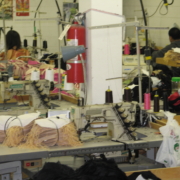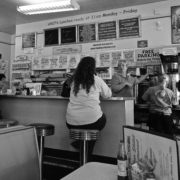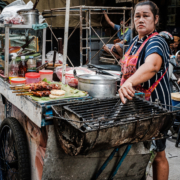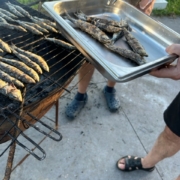What’s Up with All the Cutesy-Wootsy Small American Towns?
Across the United States, many small rural and mountain towns have adopted a carefully curated charm that feels both nostalgic and quaint.
Although these picturesque settings are appealing to some, this process often results in a loss of distinctive character.
Instead of reflecting a town’s authentic history or culture, visitors are presented with an idealized, commercialized, and homogenized version of a bygone village—one crafted to meet the expectations of tourists.
In the process, the very authenticity that once defined these places becomes diluted, replaced by a sanitized experience that prioritizes down home country aesthetics over genuine local culture.
This situation raises numerous questions.
WHAT CHARACTERIZES SUCH PLACES?
Typically small in size and population, these locations often revolve around a main street, with retail offerings designed to attract weekend and holiday tourists, generally from middle-class backgrounds and larger urban centers.
Here one or two restaurants (one of which may be a diner) serving traditional American fare with an occasional health-conscious twist do business.
Alternatively, or in a complementary fashion, these establishments seem to address Millennial and Gen Z food tastes, blending trendy, urban-inspired food ingredients (e.g., avocado, kimchi, kombucha, sriacha, truffle oil, etc.) with a local flair (e.g., heritage chicken raised from a local farm). The “general stores” offer sandwiches, soups, and salads with quirky, regionally inspired names, and artisanal local products.
Sometimes these towns even boast a high-end restaurant run by a “celebrity chef” who has ostensibly “escaped” the big city. Reservations for these venues (sometimes specializing in a farm-to-table approach to food preparation) are often booked weeks in advance, adding an air of exclusivity to the experience.
When describing dishes, staff might enthusiastically explain that the mac and cheese comes with a local twist, as if the addition of artisanal cheese reinvents the menu item.
Further down the street, visitors might find antique or vintage shops selling shabby chic furniture, and perhaps even a boutique clothing store, art gallery, or bookstore. A real estate office may be tucked away among these shops, advertising second homes to urbanites looking to escape their “stressful” city lives.
The town may even have an “up and coming” art scene, lending credence to the location’s cosmopolitan appeal.
Meanwhile, on the outskirts of town, more traditional small-town commercial establishments may still persist—perhaps a Dollar Store, a supermarket, a gas station, a Veterans of Foreign Wars post, or an auto body shop. These businesses stand in stark contrast to the curated vibe that dominates the town’s main street.
WHY & HOW DOES THIS OCCUR?
Big and small towns confront economic downturns—businesses close, unemployment rises, and younger residents leave seeking opportunities elsewhere.
Each of them deal with this challenge diffierently. Faced with few options, small towns may turn to tourism as a lifeline. The strategy is simple: attract visitors (and their disposable income) by emphasizing the town’s aesthetic appeal.
Local governments, business owners, and external investors work together to reposition these towns as desirable tourist destinations.
These towns become marketable products, their cultural identities commodified for economic survival.
At the heart of this shift is a complex deliberate interplay of aestheticization, gentrification, and commercialization, and branding.
Facades of selected retail operations are spruced up or replaced. The boarded up buildings may be torn down, and the gritty, lived-in character of a place changes to something that seems almost too polished.
In many ways, the town becomes a kind of set design, crafted to attract tourists rather than reflect the lives of those who remain.
Meanwhile sometimes these tourists, attracted by the town’s newfound charm, begin to move in, (perhaps buying vacation properties nearby), and real estate prices (and rents) rise, making it increasingly difficult for long-time residents to remain.
WHY MIGHT THIS CHANGE BE GOOD THING?
Economic development in small towns can create new jobs that allow locals to remain in their communities and improve the overall quality of life.
Service jobs in hospitality, construction, and landscaping may proliferate, providing diverse opportunities for residents.
For skilled professionals like mechanics, doctors, and lawyers, growth in local businesses could mean new clients and business expansion.
With an increased tax base, towns could invest in much-needed infrastructure updates, from roads to schools, which would benefit the entire community.
Economic development might also provide seniors with a financial cushion as they transition into retirement, offering them a chance to sell farmland or other assets for a comfortable nest egg.
But all that glitters is not gold.
WHY MIGHT THIS BE BAD?
This shift brings with it pressures to cater to the new crowd, who may have vastly different expectations and tastes than the original residents.
Beneath the surface, the towns often feel hollow. They’re no longer communities in the traditional sense; instead, they are curated experiences, designed to attract outsiders.
Meanwhile, many long-time residents of these towns, some with conservative political attitudes aligned with the MAGA movement, contrast sharply with urban visitors. This tension can predictably create some underlying friction.
The small-town charm and friendliness may sometimes feel forced or manufactured.
The sameness of these kinds of towns contributes to a considerable amount of homogenization where over time and with sufficient exposure, these towns all begin to look and feel alike.
Upon closer inspection, what initially seems charming can come across as overly contrived and staged.
The result is an experience that sometimes borders on the saccharine.
Many towns, while visually appealing, can feel hollowed out, catering more to the tastes of outsiders than to those who have lived there for generations.
Beneath the interpersonal encounters, there may also be a quiet tension from locals who rely on the influx of tourist dollars while simultaneously resenting the changes it brings.
This tension reflects a deeper question: what is being sacrificed in the pursuit of charm and economic development? As towns reshape themselves to fit an idealized image their distinctiveness can erode, making them feel more like themed attractions than genuine communities.
WHAT CAN BE DONE ABOUT IT?
Although these towns offer economic benefits by drawing in tourists, it is essential to consider the long-term implications of their curated environments.
This situation raises several key questions:
- Was there a distinct and authentic community life before the economic downturn?
- What defined this earlier period?
- In the past, were these towns vibrant places to live, work or play?
- Were these town’s histories idyllic (perhaps the majority of the residents held racist, homophobic, or otherwise discriminatory views)
- What aspects of the past are worth preserving?
- How can these towns balance tourism and economic growth while fostering a unique identity and authentic community life?
- How can economic development of the location prioritize sustainable high quality jobs?
- How can economic development avoid unitended consequences like rising living costs or overdevelopment?
- What are the available options for building a sustainable economic future?
If there was a sense of community. The question then becomes: Is the economic boost worth the sacrifice of identity? And how sustainable is a model that relies on surface-level appeal while potentially alienating the very people who gave these towns their original soul?
Although answers to these questions are not immediately clear, it is essential to remain wary of environments, rural or urban that prioritize charm over community and appearance over substance.
Photo credit
Photographer: Steve Shook
Greetings from Catskill Mountains, New York – Large Letter Postcard












